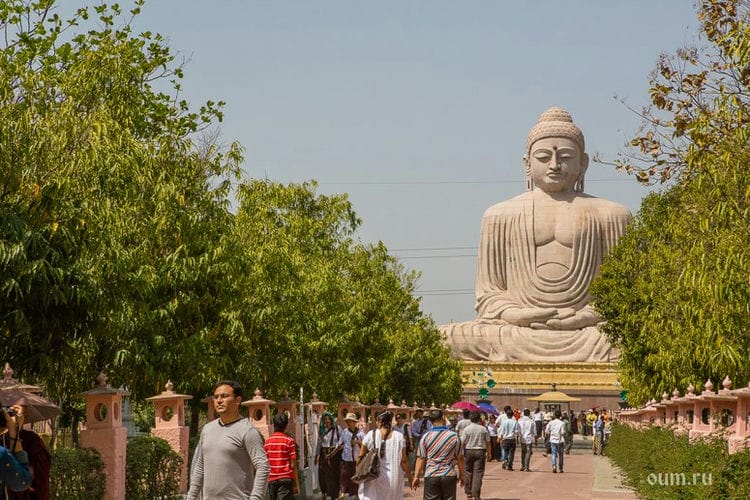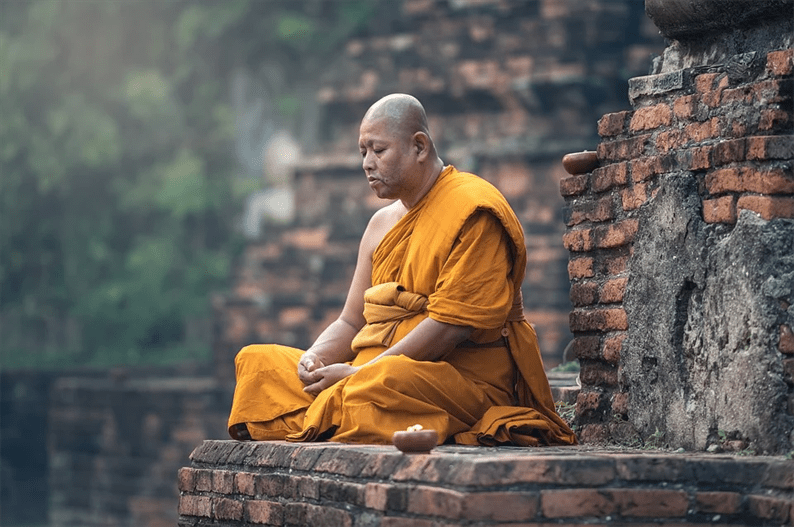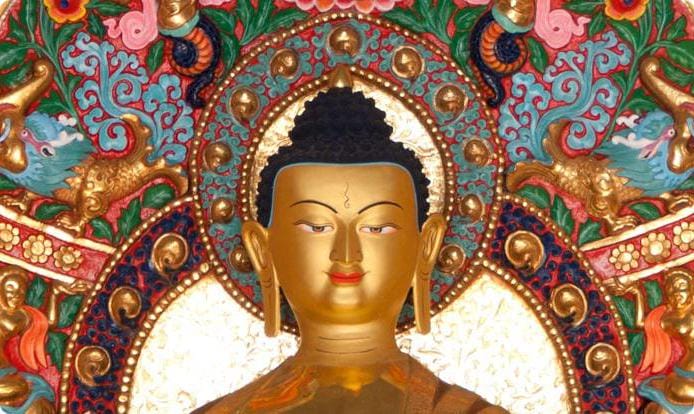Introduction
It is impossible in a short article to describe everything that I want to say about Buddhism and describe all types of schools and philosophies. But let’s try, based on the most important of them, to understand what Buddhism is and how this orthodox spiritual teaching affects the spiritualization of society, how its awareness and responsibility develops.
For this, we need to talk a little not only about religion itself, but also about how humanity went with it after several thousand years of its existence. We will try to be objective in assessing this doctrine.
Historical background
If you do not know the basics of Buddhism, you cannot understand the greatest Eastern civilizations: India, China, Tibet, Mongolia, which are literally saturated with its philosophy. The emergence of this confession dates back to the 1st millennium BC. How old Buddhism is was determined in 1956, when UNESCO decided to celebrate the 2,500th anniversary of this teaching. Symbolically, its appearance dates back to 543 BC – the year of Buddha’s entry into parinirvana. Modern research has established that the date of Buddha’s death is 486 BC.
As usual, the origin of Buddhism is associated with Prince Siddthartha Gautama, who lived in abundance and splendor, delivered by his father from all bad things. Encounters with the elder, with the leper and with the funeral procession became an incentive to spiritual changes for the tsar’s son. They informed Gautama that old age, illness and death are the lot of humanity. After that he met a serene poor traveler who did not demand anything from fate. This lesson made a deep impression on the prince and made him reflect on the fate of mankind. Leaving the palace in secret, he decided to pursue the meaning of life and at the age of 29 became a hermit.
For 45 years, Buddha spread his theory, which was the teaching of the four sublime truths. His followers called him Buddha, which means “enlightened, awakened” in Sanskrit. After his death, not a single written treatise remained. Later, other clarified individuals appeared – Buddhas, who contributed to the religious formation of civilization. Adherents of certain schools of Buddhism revered as mentors and founders of other teachings.
Where and when did Buddhism begin
The date of the origin of Buddhism is considered to be the historical moment of Buddha’s departure to another world. However, there is an opinion that it is more correct to count the years of life of the progenitor of religion. Namely, the period of enlightenment of Gautam Buddha.
According to official information recognized by UNESCO, Buddha’s parinirvana took place in 544 BC. Literally half a century ago, namely in 1956, the world was lit up with a solemn celebration of the 2500th anniversary of Buddhism.
The capital of Buddhism and other countries where the religion is preached
Today Buddhism is the state religion in 4 countries: Laos, Bhutan, Cambodia, Thailand. But the birth of this religion took place in India. About 0.7-0.8% (about 7 million people) of the population of this country preach Buddhism. This wonderful country has given the world one of the largest religions. Therefore, India is rightfully called the capital of Buddhism.
In addition to India, Buddhism is preached in countries such as China, Taiwan, South Korea, Japan, Sri Lanka, and Myanmar. In these countries, Buddhism is an officially recognized religion, which is ranked 1–2 on the list. They preach Buddhism in Tibet, Malaysia, Singapore. More than 1% of the inhabitants of Russia preach this religion.
The spread of this belief is growing. The reason for this is the special peacefulness of religion, its colorfulness, philosophical saturation, and intellectual background. Many find comfort, hope, knowledge in Buddhism. Therefore, interest in religion does not dry out. Buddhism is spreading in different parts of the world. But, of course, India has always been and will remain the capital of world Buddhism.
The rise of Buddhism
Many people who have plunged into the knowledge of Buddhism or are just studying this type of religion will be interested in how this religion arose and what is at the origins of the development of Buddhism.
The creator of the doctrine, on the basis of which the religion was formed, is Gautama. It is also called:
- Buddha is enlightened by the highest knowledge.
- Siddhartha – fulfilled his destiny.
- Shakyamuni is a sage from the Shakya tribe.
And yet the most familiar to a person who has a shallow knowledge of the foundations of this religion, the name of the founder is Buddha.
The legend of Buddha’s enlightenment
According to legend, an unusual boy named Siddhartha Gautama was born to a couple of Indian kings. After conception, Queen Mahamaya had a prophetic dream, which indicated that she was destined to give birth not to an ordinary person, but to a great personality who will go down in history, illuminating this world with the light of knowledge. When the baby was born, noble parents saw for him the future of the ruler or the Enlightened One.
Siddhartha’s father, King Shuddhodana, protected the boy from worldly imperfections, illnesses and misfortunes throughout his childhood and youth. Until his twenty-ninth birthday, the young Buddha lived in a flourishing palace, far from the frailty of life and the hardships of ordinary life. At the age of 29, a young handsome prince married the beautiful Yashodhara. The young couple had a healthy, glorious son, Rahula. They lived happily, but one day the young husband and father went out of the palace gates. There he found people worn out by disease, suffering, poverty. He saw death and realized that old age and ailments exist. He was upset by such discoveries. He realized all the futility of being. But despair did not have time to overwhelm the prince. He met a detached monk – Samanu. This meeting was an omen! She showed the future Enlightened One that by renouncing worldly passions, one can find peace and serenity. The heir to the throne left his family, left his father’s house. He went in search of the truth.
On his way, Gautama was given severe austerities. He wandered in search of sages to listen to their teachings and thoughts. As a result, Buddha found his ideal way to get rid of suffering. He discovered for himself the “golden mean”, which implied the rejection of harsh asceticism and the rejection of excessive excesses.
At 35, Siddhartha Gautama attained Enlightenment and became a Buddha. From that time on, he happily shared his knowledge with people. He returned to his native places, where his loved ones were very happy with him. After listening to Buddha, the wife and son also chose the path of monasticism. Buddha found liberation and peace at the beginning of his ninth decade. He left a huge legacy – the Dharma.
Development of teaching
Appearing in ancient India and spreading throughout the East, Buddhist thought has witnessed many events throughout its existence and endured various vicissitudes of history: the emergence of Hinduism in India, the raids of the Aryans, oppression by Muslims, the establishment of a powerful Mughal empire, modern times with its globalization.
However, dharma continues to spread throughout the world – today there are about 500 million adherents.
Basically, of course, this is the south, southeast of Asia and the Far Eastern regions: Thai, Bhutanese, Vietnamese, Chinese (especially Tibetan), Japanese, Cambodian, Lao, Korean, Sri Lankan, Myanmar, Nepalese, Mongolian territories.
In India, which is the birthplace of Buddhism, with the spread of Hinduism, the teaching has lost its meaning – here it is professed by less than one percent of the total population.
Some national republics in Russia also traditionally adhere to Buddhist views: Kalmykia, Tuva, Buryatia, part of the Altai regions. Passing them, thought moves deeper and deeper to the West: to Moscow, St. Petersburg, to European countries and to the American continent.
Fundamental views
Over the course of several years, observing his mind, Buddha concluded that people themselves become the source of human torment and sorrow: their passion for life, property and finances, belief in the inviolability and eternity of the soul. This was an experiment in creating a fallacy against global mutability. The end of torment (entry into nirvana) and awakening, in which life appears truthful and natural, can be achieved by eliminating all attachments and delusions of stability, which is facilitated by the experience of concentration and limitation, observance of the five commandments.
The Buddha stated that his theory is not a sacred prophecy, but was acquired by him as a result of meditation and observation of his own soul and other things. The position did not become dogmatic, taken on faith without criticism, and the effect depends on the follower himself. The Buddha instructed to accept his teachings only through testing by his own experience, comparing this process with the procedure for a merchant to verify the authenticity of gold upon purchase. He advised accepting his theory only after being convinced of its reliability.
Over the 25 centuries of its existence, Buddhist philosophy has absorbed a lot of various spiritual practices and rituals. Some adherents of Buddhism consider the main reflection based on meditation, others prefer to do useful things, and still others emphasize the worship of Buddha. The dissimilarity in the concepts and ideas of different Buddhist schools obliges to accept as Buddhism any teaching that traditionally becomes Buddhist and is based on the principles established by the Buddha himself. But the interpretation of concepts in different theories is sometimes strikingly different. The Theravada adherents affirm the finality of the doctrines, and the Mahayana adherents insist on their conventions, they consider them a transitional stage in the comprehension of the teachings. The same for different teachings is:
- biography of Shakyamuni;
- acceptance of retribution and transformation (samsara);
- 4 sublime truths and the eightfold path;
- theory of dependent arising.
The interpretation of these components in different schools is also ambiguous. Some Mahayana documents describe these elements only as skillful tools to draw attention to Buddhism for people of ordinary spiritual potential.
Main postulates
The main ideas of Buddhist teachings are reduced to three concepts:
- Samsara is a wheel of reincarnations, a series of reincarnations, during which people and all living beings after death reincarnate in a new world, incarnating in another body.
- Karma is the rule of causation. According to him, all our actions – good or bad – will be reflected in the future and lead to consequences. Good thoughts, actions will entail favorable consequences. Having committed any atrocity, a person will certainly feel the effect of karma on himself. Its effect extends to the next incarnations – if you behave with dignity by the standards of Buddhism, in a future life you can be reborn in higher worlds.
- Nirvana is the goal of any Buddhist, the state of liberation from suffering, when a person manages to escape from the wheel of samsara. Nirvana can be achieved through constant spiritual growth, meditation, reflection, getting rid of attachments to the benefits of humanity.
In addition, there is the concept of dukkha. It is identified with negative feelings: fear, pain, dissatisfaction, anger, anxiety, greed – generally speaking, this is suffering. Associated with the concept of dukkha are the Four Noble Truths, which are considered the foundation of the Buddhist path:
- There is dukkha – suffering.
- Every suffering has a cause, which is expressed in attachment, dependence.
- There is a path that removes suffering and leads to nirvana.
- This path is the Eightfold Path.
The octal path assumes the correct one:
- understanding – awareness that there is suffering and attachment in life;
- intentions – the desire to overcome suffering, embarking on the true path and overcoming their own vices;
- speech – observance of the purity of words;
- actions – actions that bring only good;
- lifestyle – habits that are consistent with the behavior of a Buddhist;
- effort – striving to achieve truth, sow good and renounce evil;
- thoughts – purity of thoughts, rejection of coarse, greedy, lustful ideas;
- concentration – focus on results, constant spiritual work.
The stages of the Eightfold Path must be comprehended not in turn, but all together, in a complex – they are inextricably linked with each other and lead to liberation.
We see that the steps of the Eightfold Path help to comprehend wisdom, educate moral behavior and train the mind. Buddha bequeathed that in observance of these foundations one should not rush to extremes from complete austerity to a life satiated with luxury, one should find a “golden mean” – this rule Shakyamuni called the Middle Way.
It is impossible to achieve nirvana without constant spiritual purification, meditation practices and observance of the main commandments. The latter prescribe:
- Not to harm other living beings and acts of violence – this is the so-called rule of ahimsa.
- Do not steal and do not appropriate someone else’s.
- Don’t commit adultery.
- Don’t lie to anyone.
- Do not use alcohol, drugs and other intoxicating substances.
The scriptures in Buddhist philosophy are called sutras. Different sutras are worshiped in different directions, but the essence of dharma is fully described in the Pali canon, which is called the Tripitaka.
The Tripitaka consists of several volumes:
- Vinaya Pitaka – includes the rules of conduct, the procedure for conducting ceremonies, a set of rules for monks;
- Sutta Pitaka – conveys the main points of the teachings of the Buddha;
- Abhidharma Pitaka – expounds the texts of Buddhism that reflect the concept of life.
Four classic principles
The assumptions of early Buddhism are extremely simple and based on four classical principles:
- Life is suffering;
- This truth explains why there is suffering – we suffer because we ourselves want it;
- This principle of Buddhism talks about observing ourselves in order to get out of the grip of suffering, while we must completely give up our desires. In Buddhism, this means knowing complete bliss, tranquility, getting rid of worldly passions, eradicating hatred and knowing the true nature of things, that is, reaching the state of nirvana. To cognize this state, Buddhist monks undergo training, meditate, engage in patronage, worship saints and thereby free themselves from their own ego (called “moksha”), rejecting human desires and passions. There are two ways of salvation: 1) Hinayana is a narrow way of salvation, it is achieved in Buddhist monasteries, and the knowledge of nirvana comes after death; 2) Mahayana – a wide path, cognition of nirvana occurs for a time during life, and after death it is achieved forever.
- This rule is a series of instructions on how to achieve this state (coinciding at many points with the Christian Ten Commandments). Every Buddhist during his mundane life follows the middle path of existence on the path to attaining nirvana – this is the basic teaching of the Buddha, also called the eightfold path of salvation. It is based on eight states:
– correct speech – abstaining from lies, foul language, idle talk and speeches that can sow enmity and lead to evil;
– the correct way of life – not to harm all living things, to earn a living without contradicting Buddhist values, to lead a modest life, without luxury and other excesses;
– concentration – strive to get rid of rigid beliefs and fill your mind with positive thoughts, learn to contemplate and learn the truth;
– correct view – understanding of the Four Noble Truths (Samsara is suffering; suffering has a cause and an end; there is a path leading to the end of suffering);
– doing the right thing – doing good deeds, refraining from theft, adultery and the desire to beat other creatures;
– correct thoughts – to understand that all evil comes from our flesh;
– correct intentions – to change your desires and intentions. Replace cruelty and harm with compassion; sensual pleasures – for dedication to spirituality; anger – for goodwill.
– the right efforts – to drive away all evil, tune in a positive mood and try to always follow your thoughts.
These are the foundations of Buddhism, which over the centuries have been fully transformed into the state religion, and have also become an integral attribute of the secular and cultural life of the entire eastern community.
The uniqueness of dharma
Buddhism as a religion is unique in its kind because it has many differences from other religions. He absorbed the features of both religion and philosophy. That is why it is more correct to call Buddhism a religious and philosophical doctrine.
Buddhist teaching differs from other religions in many ways:
- in the center is not the Creator, the One God or several gods;
- there is no concept of the universe – no one created it and no one controls it;
- the number of worlds is infinite;
- there are no sins and their atonement – there is only karma, which is considered the law of life;
- there are no unconditional dogmatic rules;
- Buddha bequeathed that there can be no blind faith – all truths should be passed through oneself and tested by one’s own experience;
- the Buddha’s teaching does not consider itself the only correct one – Buddhists can simultaneously accept another religion, without violating the rules of the dharma;
- the teaching does not get rid of the “divine punishment” that is in other faiths – it leads to the knowledge of one’s own nature and spiritual development.
Unlike Hinduism, which is also based on the laws of karma, samsara, rebirth, Buddhist philosophy considers all people equal, regardless of their position in society and origin – as opposed to varna and caste in Hinduism.
However, Buddhist philosophy, spreading to more and more lands, poured into different currents and took different forms. Each school took on its own characteristics, and some areas became more like a religion, such as Tibetan Buddhism.
In this case, Buddha is deified: offerings are made to him, altars are erected, statues are made, images that look like icons are made. A pantheon of buddhas and bodhisattvas appears – enlightened ones who help other people to gain liberation.
There are more and more temples, which are also called datsans, khurals, vats, monasteries. Monks in special attire, services in temples, holidays, meditations with the recitation of mantras, rituals – in some directions, all components of the religious movement can be traced. Thus, Buddhism refers to philosophy and religion at the same time – everything depends on the school of dharma.
Concept of God
A few Buddhist schools worship Buddha as God, but other adherents of the teachings see him as their founder, teacher and civilizer. They profess that the attainment of enlightenment will be possible only through the resources of the universe. Therefore, Buddhism does not recognize a creator God, omniscient and omnipotent. Every person is an element of deity. Buddhists do not have one unchanging God; every enlightened person can receive the title of Buddha. This concept of God distinguishes this denomination from many Western spiritual teachings.
Buddha himself in every possible way denied the idea of the existence of a creator who created the Earth and life on it. Buddhist meditators generally believe that belief in God is a hindrance to the path to nirvana.
Although Buddhism does not recognize God, the teachings feature creatures that are roughly close to the divine essence – devas. But one cannot understand them in the same sense as deities in Western religions. They are tested by sorrows and torments like people, undergoing rebirth in the wheel of samsara. Buddha becomes the wisest in the host of deities, he is called the teacher of the gods. Various teachings of Buddhism have representations that are likened to deities. God in Buddhist teachings is called by various names:
- the creator, or the origin – the basis of the origin of the world and all living things, which cannot be understood with the help of reason;
- brahmin – a spiritual being who realizes himself after the resurrection;
- ideal, identical to the absolute mind.
Philosophy of Buddhism
Buddhism is self-observation in order to go beyond one’s usual self. The ordinary human “I” is based on past experience, on the real perception of this world, on the ego. But when a person engages in self-observation, he notices that “I” is an illusion and no “I” exists in the body.
The philosophy of Buddhism contains such a concept as the illusory nature of this world. This religion says that anyone can realize their illusoryness by examining and examining their body. Observing him, we do not find anything, everything only depends on each other in its existence and there is no “I” in this body.
So a person plunges into himself and, comprehending different worlds, becomes convinced of the existence of other dimensions and his attachment to this world weakens.
Usually, when a person dies, he returns to himself Home, to his Father, to God, where there is only Unity. But when asked if he wants to return to the state of separation, he replies that he wants to return because he is attached to the previous experience. Based on the foregoing, this is the philosophy of Buddhism that a person returns to his labyrinth on Earth.
In other words, a person amuses himself or plays with those things that exist in the human world. After the death of a person, they again ask if he has played enough of his earthly games. And there are so many toys in the world of people and of which there are more and more. And the child again says, “Yes.” And again wandering through the labyrinth of life.
In order to understand what Buddhism is, one must first accept the fact of the existence of the labyrinth and its infinity. And what needs to be done is to rise above the maze, see your toys in this maze.
And when you see that the real “I” is absent in this body, that playing with toys brings suffering, then the desire to possess these toys disappears and there is no longer any need to wander in the labyrinth. Samsara’s wheel stops.
Having left the labyrinth, a person becomes the Ocean of Consciousness, and the Ocean is everything. Why be a small droplet, experiencing drought and cold winds, when the Ocean is always warm and there is no suffering?
The concept of nirvana in Buddhism
One of the ultimate goals of Buddhism is to return to their native Home, which is also called the Void or Nirvana. What does Nirvana mean in Buddhism? This is the birthplace of all things, a place where there is complete freedom, unlimited happiness and bliss. The concept of nirvana in Buddhism means a place where there is nothing to know, because there is the fullness of everything.
Finding Nirvana is the very main key, what Buddhists believe in and what the essence of the teaching is. Man and living beings continue to be born and reborn in different worlds, because they strive to distinguish objects. Thus, an infinite number of different worlds are created in the entire Universe.
For example, in the case of a person, then the person wants to know, and he seeks to distinguish between himself and others. So he moves away from his Source, from the Unity of all that exists.
In Buddhism, many practitioners have attained the state of Emptiness or Nirvana. In their meditations, they entered Samadhi, in which there is a complete cessation of breathing and heart. And it is in Samadhi that desires, experiences and discrimination are completely destroyed.
When there is no discrimination, then a person will no longer be born in any world. Therefore, the state of Emptiness is not just a place where there is nothing, but on the contrary there is Unity with everything. A place where time stands still and space is filled with endless bliss. Therefore, Buddha said: “Do not ask me about Nirvana, it is impossible to understand with the human mind.”
The concept of nirvana in Buddhism plays a decisive role, it is believed that this state is inherent in every person. This is the true state of a person, which is sometimes called the True Self, Atman or God.
In Christianity, God has a “male” gender, but this is more connected with patriarchy, with the dominant male role in society. Most likely, God is Mother or Emptiness in which everything is born. Indeed, in order for something to exist, including God, there must be space for this, and this is the Great Emptiness.
About the Buddhist Path
Buddhism brings together a large number of different independent schools and traditions. But they all have one common basis – all Buddhists recognize Buddha, Dharma (that is, the teachings of Buddha) and Sangha (spiritual community of Buddhists) as three fundamental religious values. These are the so-called three shelters. The meaning of Buddhist practice is to achieve enlightenment, the realization of Buddha nature in a person. It is in the light of this goal and for the sake of it that all rituals are performed, mantras are recited, meditations are practiced, and so on. However, Buddhism has many faces, and its various denominations sometimes differ significantly from each other. Therefore, with regard to the initial practice, what is required of an adherent of Japanese Zen is very far from what is offered to a follower of the Tibetan Gelugpa. We will focus mainly on the traditions of Tibetan Buddhism,
What is the practice
Followers of Buddhism strive to free themselves from the clouding of mind, which distorts the true reality. They try to get rid of negative qualities:
- anger,
- bitterness,
- anxiety,
- horror,
- ignorance,
- barbarism,
- pride,
- egocentrism,
- laziness,
- distrust,
- envy,
- greed,
- discontent.
The merit of the doctrine is the education in its adherents of pure and exalted qualities:
- humanity,
- generosity,
- gratitude,
- mercy,
- sympathy,
- diligence,
- prudence.
These properties contribute to the gradual mastery of the truth and purification of the mind, which results in a stable feeling of well-being. By working on their mind, strengthening, ennobling and making it brighter, Buddhists relieve anxiety, irritation and discontent, which ultimately lead to unhappiness, despondency and depression. This is why Buddhism is becoming an indispensable condition for enlightenment and the irrevocable release of consciousness. Buddhism is considered a religion of the worldview, not a supernatural plan.
Self-acceptance of Buddhism
This topic must be touched upon, because many people, having read Buddhist literature, suddenly decide to become Buddhists and immediately begin to practice certain meditations or rituals. However, not all so simple. A person, of course, can and must independently believe in the truth of Buddhist teachings. But to consider yourself a full-fledged Buddhist, that is, a member of the sangha, a simple solution is not enough. In order to enter the spiritual community, it is required to accept the so-called three jewels. This is also called the refuge vow. It is he who introduces a person to Buddhism. It is very important for beginners that this vow is taken the first time by one of the authorized servant lamas. This requires a personal meeting with the lama and the taking of the refugee vow ceremony.
Clear vision
The main practice of a Buddhist should be aimed at developing the skill of pure seeing. The latter implies that a person must totally and completely abide in the “here and now”, freeing his mind from building spatio-temporal connections. The mind should not be somewhere in another time or think about other places. It should reflect the current reality – the time and place where the person is at the current moment. When this skill develops, the perception changes, it becomes pure. This is the first step towards discovering the Buddha nature. The state of “here and now” is meditation, its inner content. Thus, a Buddhist, no matter what they are doing – drinking tea, cleaning the apartment or preparing food, should strive to stay in meditation through the development of a sense of “here and now.”
Home meditations and mistakes
There are many different meditation techniques in Tibetan Buddhism, and some of them are extremely difficult and even dangerous, and therefore they are transmitted secretly. But the practices of Buddhism for beginners are usually safe and it is almost impossible to make a mistake in them, if you do not approach, as they say, “creatively”, that is, changing the practice, introducing new elements into it and eliminating the old ones. In addition, in Buddhism, it is assumed that a new convert is engaged in practice under the guidance and with the blessing of his mentor, who taught him three refugees (that is, took him into the fold of Buddhism and a particular Buddhist school), as well as instructions on how to practice. It is virtually impossible to independently accept Buddhism without this ceremony.
Types of Buddhism
I do not pretend to be an exhaustive completeness of the narrative, I show only the main types of Buddhism and the huge cultural life that is hidden behind one of the most numerous religions in the world.
Theravada Hinayana. This type of Buddhism survived in South Asia and includes South India, Ceylon, Indochina. This is the oldest form of Buddhist teaching. Very old texts of the Buddhist canon have survived, which contains a rich collection of commandments and parables. It is the most primitive form of Buddhist religion and is not widespread.
Chinese Buddhism. Raised in India, he headed to China, which became the ideal “relay station” to the entire East and then to the West. As a result of such complex metamorphoses and transformations, the Ch’an school was created in China, which is the basis of Zen Buddhism, which spread to Japan and Korea. The school was founded by Bodhidharma Buddha, who arrived in China in the 5th century BC. Over time, it has become the most important original form of Chinese Buddhism, which has gained a prominent place among other areas of systems thinking and beliefs in China – Confucianism and Taoism.
Tibetan Buddhism. It is the most colorful, most scenic Buddhist destination in the world. It consists of two elements. First, the structure of the religion itself is Lamaism, another name for Buddhism currently used in Tibet. It became the main local belief – a religion full of ghosts, magic and gods. The second characteristic of Lamaism is very different from other schools of Buddhism – it is the unusually strong position of the priests (lamas). Tibet before the Chinese invasion was the most theocratic state in the world – a third of the population were monks.
Japanese. This type of Buddhism is divided into several sects, of which I will discuss the most important in chronological order. They originate from two main traditions – Rinzai and Soto.
Shin Buddhism comes from the name of Amida Buddha, who reigns in the paradise of the “pure land”. In order to go to heaven, a Buddhist must pronounce the name of Amida Buddha. This concept is widely known throughout the history of the development of Buddhism in India and China, but only in Japan, the monk Honen (1133-1212) announced that the inspired utterance of the name of Buddha is enough. You do not need good thoughts, deeds or meditations, you just repeat the formula of Namu Amida Butsu (hence the other name for this sect – nembutsu) and this can achieve salvation.
The monk Sinran, who lived 1173-1262 and was a disciple of Honen, after a while came with his own original thesis that the very existence of every person’s life is not given by the Buddha and no longer need to call his name in order to be saved and come to eternal bliss and harmony.
Nichiren is perhaps the most controversial version of the Buddha’s teachings. The sect was founded by Nichiren, who lived from 1222-1282 and was a great religious reformer. Historical events of that time contributed to the origin of this tradition – Japan was haunted by military conflicts and natural disasters.
He used this fact to argue that in order to achieve peace and tranquility, one religion needs to be created in Japan – Buddhism in such a form that it contributes to the achievement of enlightenment. Thus, a fanatical, ultranationalist religious movement is created, a kind of “Japanese national Buddhism.”
What is Zen Buddhism ? It is the most advanced form. Rejects any external religious attributes – hierarchies and rituals, as well as any intellectual aids that contribute to enlightenment (sermons and holy books of Wisdom). Enlightenment comes here and now, and only through contemplation is liberation from selfishness. This state is achieved through zazen or sitting in the lotus flower position, rejoicing in the breath – these are the conditions necessary in order to accept the compassionate Buddha nature.
Rinzai Zen. Rinzai is the most important Japanese Zen movement, also founded by a monk who was not very satisfied with Japanese Buddhism and decided to travel to China (from where Buddhism came to Japan) to learn the true understanding of this religion. Thanks to him, the fundamental principles of Buddhism (Chinese Ch’an) were spread to the Japanese islands, called in the new dialect Zen. This is the beginning of one of two major Zen traditions;
Soto Zen. Soto is a Japanese school founded by a monk named Dogen, who was a student of Reverend Rinzai and took many elements of thought from him. Nevertheless, like a mentor, he single-handedly traveled to China to local sources in order to comprehend the knowledge of the true dimension of Buddhism. This is how another type of Japanese Zen appeared, which is still popular and is practiced by a lot of fans.
Korean Buddhism. In Korea, this type of teaching has centuries-old traditions. However, one hundred or two hundred years ago, it seemed that this teaching had lost its meaning. This was until the middle of the twentieth century. But in the wake of the growing interest in Zen Buddhism in the West, Korean Buddhism is also undergoing a revival. The best example is the Zen Kwame Um school.
Perhaps the species presented here and their brief descriptions were useful for those interested in this ancient religious denomination. I am deeply convinced that the idea of being a Buddhist is one of the most valuable human desires, which in some strange way is close to every person.
Conclusion
Buddhist faith, like faith in general, gives strength, inspires, inspires, helps to get on the true path. We were glad to slightly open the door to the soul of a Buddhist for you. May there be light and peace in your life!
Sources used and useful links on the topic: https://avisi.ru/chto-takoe-buddizm-osnovnye-vidy-i-koncepcii-buddizma.html https://mystroimmir.ru/religiya/buddizm.html https: // www.oum.ru/literature/buddizm/istoriya-vozniknoveniya-buddizma/ http://o-buddizme.ru/osnovy-buddizma/buddizm https://samosoverhenstvovanie.ru/chto-takoe-buddizm-i-vo-chto -veryat-buddis / https://nlo-mir.ru/religia/43051-buddizm-dlja-nachinajuschih.html http://o-buddizme.ru/osnovy-buddizma/vo-chto-veryat-buddisty










